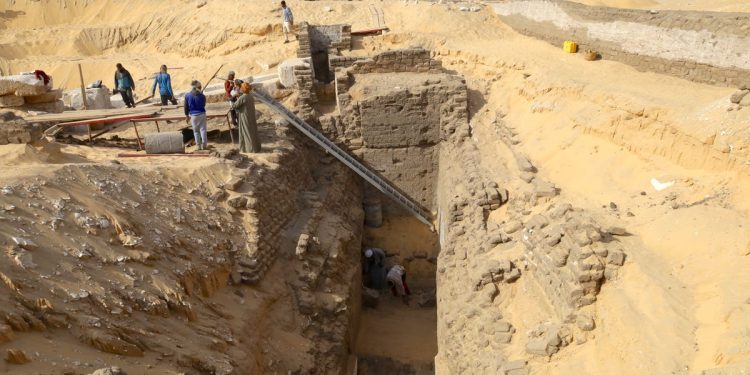Do you have an account? .
- Archaeologists have found a new grave of Pharaoh at Anubis Mountain in Egypt.
- The tomb comes from the mysterious Abydos dynasty of warrior kings in a chaotic historical era.
- The identity of the pharaoh is a mystery for the moment. Discover his grave.
Archaeologists discovered a mysterious new king of ancient Egypt, buried in a network of tombs in Anubis Mountain.
“Discovering King’s graves, the new Pharaohs, are rare,” said Josef Wegner, a team leader who discovered the new tomb, told Business Insider.
Researchers do not know the identity of this pharaoh because they think that former tombs thieves have damaged the marking of his name on the tomb wall. However, it could help to light a forgotten era of Egyptian history of around 1640 BCE in 1540 BCE, when war pharaoh fought for the territory.
“It is a truly fascinating period of agitation, conflict,” said Wegner, who teaches Egyptian archeology at the University of Pennsylvania and organizes the Egyptian section of Penn Museum.
“This gives birth to the new kingdom, the famous golden age of many well-known pharaohs like King Tut and the Kings Ramses,” he added.
Take a look at this unknown pharaoh’s tomb.
Wegner’s team searched the tomb aged 3,600 under 23 feet of sand with the Anubis mountain necropolis.
Dr Josef Wegner for the Penn Museum
This is part of Abydos, one of the oldest cities in ancient Egypt and which formerly houses the little -known Abydos dynasty, which, according to archaeologists, was one of the many kingdoms at war through Egypt during the second intermediate period of the region.
“It’s a mystery dynasty,” said Wegner about the kings of Abydos.
Dr Josef Wegner for the Penn Museum
Today, the ancient city is home to a sprawling archaeological site, where the kings of Abydos have transformed the necropolis into a royal cemetery.
Wegner’s team had already discovered a grave in the region in 2014, housing the remains of a pharaoh named Seneb Kay.
With the kind authorization of Josef Wegner, Penn Museum
Seneb Kay was proof of the wars of this period. Raiders of ancient tombs had removed his body from his burial place and left him in another room. Centuries later, the researchers examined the skeleton and found 22 traumatic injuries in his bones, including the battle axis that cracked his skull. They concluded that he died in combat.
The walls of the tomb of Seneb Kay were decorated with colorful paintings, including hieroglyphs named after the king.
With the kind authorization of Josef Wegner, Penn Museum
Then they discovered seven other non -decorative tombs surrounding his, for a total of eight kings Abydos.
“We thought we had exhausted all the evidence until this last winter season in Abydos, where we started working in a new section of the site,” said Wegner. “And here it is, there is another of these tombs which is much greater than those we had found before.”
Like the tomb of Seneb Kay, he was decorated with paintings – including hieroglyphs named Pharaoh.
Dr Josef Wegner for the Penn Museum
At the dismay of Wegner, however, the former tombs of tombs had damaged the painting of the hieroglyph and made the name illegible.
“It was, of course, a little frustrating that we could see where his name had been preserved,” said Wegner.
This pharaoh was probably a predecessor of Seneb Kay.
Dr Josef Wegner for the Penn Museum
Small monuments dedicated in the region, Wegner knows two Abydos kings which have not yet been found, which could be the person in this new tomb. Their names are Senaiib and paentjeni.
Wegner always hopes to confirm the identity of the new king.
Dr Josef Wegner for the Penn Museum
The archaeological team can find clues by excavating the surroundings. Wegner said they had finished searching the inside of the tomb since he had discovered it in January.
A detail gives him hope: they have not yet found the canopic pots of this Pharaoh mystery, which store the organs of a mummy.
Dr Josef Wegner for the Penn Museum
Sometimes the tombs thieves grabbed and later threw canopic pots, said Wegner. It is also common that such pots have the name of the mummified pharaoh. He hopes to find a fragment of one of these pots with the name of this king.
“It would be an immediate positive identification,” said Wegner.
Wegner plans to return to the site this summer for new excavations.
Dr Josef Wegner for the Penn Museum
They have an “important area” where they want to continue to dig, he said, both for additional evidence of this tomb and to also check the other tombs.
The Anubis mountain region has given much more history than WeGner expected when it started working there in the 1990s.
“We realized that it is a complete royal cemetery,” he said, “like a valley of kings.”
businessinsider


